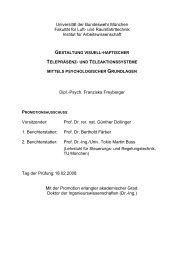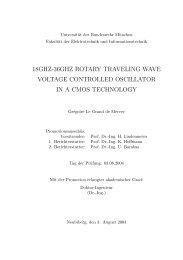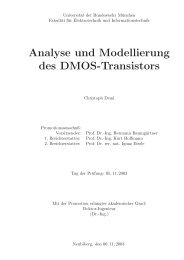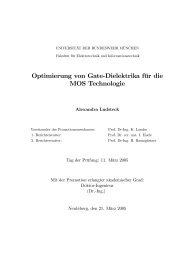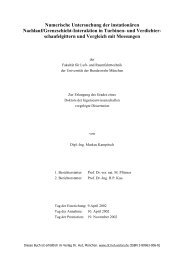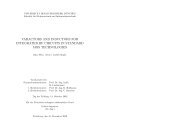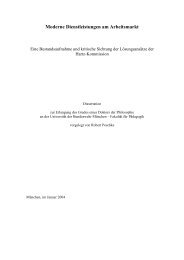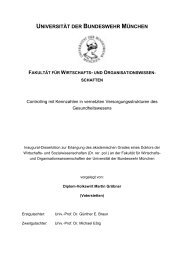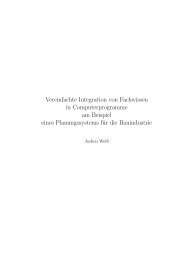Precise Orbit Determination of Global Navigation Satellite System of ...
Precise Orbit Determination of Global Navigation Satellite System of ...
Precise Orbit Determination of Global Navigation Satellite System of ...
Create successful ePaper yourself
Turn your PDF publications into a flip-book with our unique Google optimized e-Paper software.
Chapter 8 Geostationary <strong>Orbit</strong> <strong>Determination</strong> And Prediction During <strong>Satellite</strong> Maneuvers<br />
To counteract these drifts due to perturbations, sufficient fuel is loaded into the maneuver rockets onboard <strong>of</strong> all<br />
geostationary satellites to periodically correct any changes over the planned lifetime <strong>of</strong> the satellite. These<br />
periodic corrections are known as stationkeeping or satellite maneuvers. North-south stationkeeping corrects the<br />
slowly increasing inclination back to zero and east-west stationkeeping keeps the satellite at its assigned position<br />
within the geostationary belt. These maneuvers are planned to maintain the geostationary satellite within a small<br />
distance <strong>of</strong> its ideal location (both north-south and east-west). This tolerance is normally designed to ensure the<br />
satellite remains within the ground antenna beamwidth without tracking.<br />
In Germany, Deutsche Telekom owns and operates three geostationary telecommunication and direct<br />
broadcasting satellites. The Telekom DFS-Kopernikus satellites are maneuvered in longitude (EW) on a weekly<br />
and in inclination (NS) on a two week basis. TVSAT-2 is operated in EW and NS on a two week cycle. It results<br />
that the Flight Dynamics <strong>System</strong> has to cope with 11 maneuvers on a fortnight basis (Bisten, M.& Damiano, A.<br />
1996)<br />
8.2 <strong>Orbit</strong> <strong>Determination</strong> During <strong>Satellite</strong> Maneuvers<br />
If a geostationary satellite is used for navigation purpose, the orbit information (ephemeris) should be<br />
continually broadcasted to the users for their navigation and positioning computation. Due to the large orbit<br />
errors during satellite maneuvers, the orbit information at that time can not be used. During this period, users<br />
have to stop their navigation and positioning applications. Normally, the geostationary satellite maneuver is<br />
operated weekly, which makes a big problem for navigation users to get correct orbit information in real-time. In<br />
order to overcome this problem, the precise orbit determination and prediction methods during satellite<br />
maneuver should be considered.<br />
The situation <strong>of</strong> satellite orbit changes during the satellite maneuver can be shown in Figure 8-4.<br />
5: <strong>Orbit</strong> After<br />
Maneuver<br />
2: Predict <strong>Orbit</strong><br />
before Maneuver<br />
4: Predict <strong>Orbit</strong><br />
during Maneuver<br />
T2: Maneuver Stop<br />
Figure 8-4 Three Phases <strong>of</strong> GEO <strong>Satellite</strong> Tracks during Maneuver<br />
Figure 8-4 shows five tracks <strong>of</strong> GEO satellite orbit. Track 1 is an orbit track before maneuver; Track 2 is the<br />
predicted orbit before maneuver; Track 3 is the track <strong>of</strong> GEO satellite during maneuver; Track 4 is the predicted<br />
orbit during maneuver; Track 5 is a satellite orbit after maneuver. Tracks 1, 3 and 5 are actually GEO satellite<br />
orbits. Without maneuver operation, actual GEO satellite tracks should be Track 1 and Track 2. Normally GEO<br />
satellite orbit is determined and predicted using precise satellite dynamic models which include geopotential,<br />
solar and lunar attractions, solar radiation pressure etc., but no satellite maneuver force model is included due to<br />
difficulties to model the maneuver force. Currently, the most <strong>of</strong> the GEO satellites are used for communication<br />
purposes, people are more concerned about GEO satellite drift, they are not so interested in the actual satellite<br />
orbit. But for navigation application, the actual orbit <strong>of</strong> GEO satellite is very important. Users need the actual<br />
position and velocity <strong>of</strong> GEO satellite as references to compute their own positions and velocities.<br />
There are two phases that are big problems for satellite navigation application during satellite maneuver. The<br />
first phase: satellite maneuver begins at T1(see Figure 8-4); navigation users use the predicted orbit Track 2<br />
(predicted before maneuver), but the actual orbit is Track 3. This will introduce a big orbit error for the<br />
navigation users in their navigation computation. The second phase is that the satellite maneuver stops at T2, the<br />
104<br />
3: <strong>Orbit</strong> During Maneuver<br />
1: <strong>Orbit</strong> Before Maneuver<br />
T1: Maneuver Start



